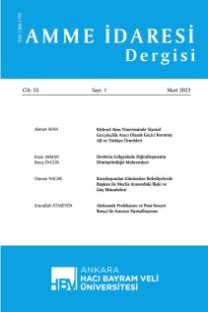Rekabet Kurumu’nun Etkinliğinin Ölçülmesi: Veri Zarflama Analizi Uygulaması
Measurement of the Efficiency of the Turkish Competition Authority: An Application of Data Envelopment Analysis (DEA)
___
- Banker, R.D., Charnes, A., and Cooper, W.W. (1984), “Some Models for Estimating Technical and Scale Inefficiencies in Data Envelopment Analysis”, Management Science, 30(9), 1078 – 1092.
- Boles, J. N. (1966), Efficiency Squared – Efficient Computation of Efficiency Indexes, Proceedings of Thirty Ninth Annual Meeting of the Western Farm Economics Associa-tion.
- Boussofiane, A., Dyson, R., ve Rhodes, E., (1991), Applied Data Envelopment Analysis, European Journal of Operational Research, 2(6), 1 –15.
- Bowlin, W. F. (1998), “Measuring Performance: An Introduction to Data Envelopment Analysis (DEA)”, The Journal of Cost Analysis, 3–27.
- Caves, D., Christensen L.R. ve Diewert W.E. (1982), The Economic Theory of Index Numbers and the Measurement of Input, Output, and Productivity, Econometrica, 50 (6): 1393-1414.
- Charnes, A., Cooper, W.W., and Rhodes, E. (1978), “Measuring the Efficiency of Deci-sion Making Units”, European Journal of Operational Research, 429-444.
- Coelli, T.J., Rao, D.S.P., O’Donnell, C.J., and Battese, G.E. (2005), An Introduction to Efficiency and Productivity Analysis, 2nd edition, Springer
- Coelli, T. (1996), A Guide to DEAP Version 2.1: A Data Envelopment Analysis (Comput-er) Program. Centre for Efficiency and Productivity Analysis, University of New England, Australia.
- Cooper, W.W., Seiford, L.M. ve Tone, K. (2007). Data Envelopment Analysis: A Com-prehensive Text with Models, Applications, References and DEA-Solver Software (2. Bs) [Elektornik Sürüm]. New York: Springer Science +Business LLC.
- Curristine, T., Joumard, I. ve Lonti, Z. (2007), “Improving Public Sector Efficiency: Challenges and Opportunities”. OECD Journal on Budgeting, 7(1), 1-41.
- Çakır, S. ve Perçin, S. (2012), “Kamu Şeker Fabrikalarında Etkinlik Ölçümü: VZA - Malmquist TFV Uygulaması”, Anadolu Üniversitesi Sosyal Bilimler Dergisi, 12, 4, 49-64.
- Çelen, A. (2013). “Efficiency and productivity (TFP) of the Turkish electricity distribu-tion companies: An application of two-stage (DEA&Tobit) Analysis” . Energy Policy, 300-310.
- Dumlupınar, Ö. (2009), Avrupa Birliği’nde ve Türkiye’de Rekabet Politikasının Sanayi Politikası ile İlişkisi, Yüksek Lisans Tezi, Ankara Üniversitesi, Ankara.
- Esen, Ş. (2006). Piyasaların Rekabetçi İşlevlerini Sürdürmesinde Rekabet Hukukunun Rolü: Piyasaya Giriş Engellerinin Rekabet Hukuku Açısından Değerlendirilmesi. Dokto-ra Tezi, Sakarya Üniversitesi, Sakarya.
- Fare, R., Grosskopf, S., and Logan, J. (1983), “The Relative Efficiency of Illinois Electric Utilities”, Resources and Energy, 5, 349-367.
- Fare, R. (1988), Fundamentals of Production Theory, Lecture Notes in Economics and Mathematical Systems, Heidelberg: Springer-Verlag.
- GCR (2016), Global Competition Review Rating Enforcement Report.
- GCR (2017), Global Competition Review Rating Enforcement Report.
- Isik, I. ve Hassan, M. K. (2003), Financial Disruption and Bank Productivity: The 1994 Experience of Turkish Banks, The Quarterly Review of Economics and Finance, 43: 291–320.
- Karacan A.İ. (2002), “Özerk kurumların özerkliği?”, Rekabet Kurumu Perşembe Konfer-ansları, Ankara.
- Kitzmuller M. ve M.M. Licetti (2012), Competition Policy: Encouraging Thriving Mar-kets for Development, Worldbank (Note Number 331). http://siteresources.worldbank. org/EXTFINANCIALSECTOR/Resources/282884-1303327122200/VP331-Competi-tion-Policy.pdf, (07.11.2017)
- Malmquist, S. (1953), “Index numbers and indifference surfaces”, Trabajos de Esta-distica 4, 209–242.
- Markovits-Somogyi, R. (2011). “Ranking efficient and inefficient decision making units in Data Envelopment Analysis”. International Journal for Traffic & Transport Engineer-ing, 1(4).
- Rekabet Kurumu. (2013), Yatay İşbirliği Anlaşmaları Hakkında Kılavuz, http://www. rekabet.gov.tr/File/?path=ROOT%2F1%2FDocuments%2FKilavuz%2FYatayis-birligikilavuz.pdf, (07.11.2017).
- Sezen, S. (2015), “Türkiye’de Düzenleyici Kurulları Kimler, Nasıl Yönetiyor?”, Amme İdaresi Dergisi, 38(4), 85-115.
- Sherman D. (1984), “Data Envelopment Analysis as a New Managerial Audit Methodol-ogy-Test and Evaluation”, Auditing A Journal of Practice and Theory, 4, 35-53.
- Shephard, R.W. (1970), The Theory of Cost and Production Functions, Princeton Uni-versity Press.
- Tan T. (2002), “Bağımsız İdari Otoriteler veya Düzenleyici Kurullar”, Amme İdaresi Der-gisi, 35 (2), 11-37.
- TDK (2017), Türk Dil Kurumu Güncel Türkçe Sözlük, http://www.tdk.gov.tr, (07.11.2017).
- Türkkan, E. (2003), Vizyon Rekabeti. Ankara: Liberte Yayınları.
- ISSN: 1300-1795
- Yayın Aralığı: 4
- Başlangıç: 1968
- Yayıncı: -
Eğitim Yönetiminde Olgu-Değer Sorunsalına İlişkin Görüşlerin Değerlendirilmesi
Günümüz Örgütleri İçin Yetenek Yönetimi Modeli Önerisi: Devşirme Sistemi
OSMAN BAYRAKTAR, NİHAT ALAYOĞLU
Rekabet Kurumu’nun Etkinliğinin Ölçülmesi: Veri Zarflama Analizi Uygulaması
AYDIN ÇELEN, Başak DALGIÇ, Aybars İlter ÖZESKİCİ
Tanzimat’tan Cumhuriyet’e Cuma Tatili
KAMİL DEMİRHAN, F. Hilal ONUR İNCE
Özel Askeri Şirketlerin Savunma Politikaları Açısından İncelenmesi
METE YILDIZ, Alper EKMEKÇİOĞLU
Üniversite Eğitim ve Araştırma Hastane Döner Sermayelerinin Mali Performansı ve Risk Alanları
